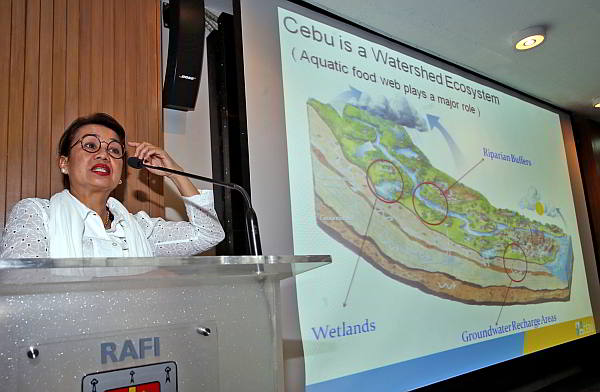‘Allow rainwater to seep into ground’

Architect Joy Onozawa discusses Cebu’s water problem during the Mega Cebu forum at the Ramon Aboitiz Foundation Inc. plenary hall. (CDN PHOTO/JUNJIE MENDOZA)
Property developments should include plans and methods that allow rainwater to seep into the ground instead of flowing into sewers, rivers and seas.
Urban planner and environmental advocate Ma. Lourdes “Joy” Onozawa said rainwater should fall to the ground to replenish the underground water supply and prevent existing water from mixing with salt water.
This would also prevent soil erosion and flooding.
“Right now what we’re doing is depending on concrete culverts. We’re sending all our water back to the rivers or sea and that is totally wrong. We’re preventing water from going down to the ground,” she told Metro Cebu government officials during a Mega Cebu meeting.
Aside from cooling the earth, Architect Onozawa said rainwater preserves the quality and increases the volume of water in the province, thus ensuring a stable water supply for future generations.
Redirecting the rainwater to the sewers, rivers and sea is unhealthy for the environment and prevents the earth from naturally replenishing its underground water supplies.
Salt water, which is unfit for human consumption, is then pushed into the supply to fill the void.
“Most of our areas in Cebu are already infiltrated with salt water and that takes a long time to fix,” the architect said.
To minimize the damage and, at the same time, filter the rainwater, Onozawa proposed a series of development strategies that real estate and land developers can use to increase ground permeability.
SUGGESTIONS
Some suggestions include using permeable paving systems such as porous asphalt and porous concrete in building roads or pathways in order to allow rainwater to seep through the cracks and into the ground.
She also suggested the construction of rain gardens that help rainwater flow into the ground in homes.
Types of rain gardens include bio-retention ponds, which are gardens with vegetation indigenous to the area that absorb excess storm water.
“Bio-retention ponds are good for parking spaces. There are small spaces in parking lots that don’t need to be completely covered in cement,” she said.
Urban planter boxes also work similarly, storing runoff water before draining.
Onozawa said these are ideal for smaller spaces or highly urbanized areas, such as in subdivisions with tightly packed houses.
TRENCHES
For sidewalks along roads or street corners, the architect recommended designing tree trenches, or curb extensions.
Onozawa said tree trenches are designed to absorb runoff water from surrounding areas that are non-permeable like packed concrete.
Trees, which help absorb the runoff water, are planted in the trenches.
She said this adds aesthetic value to the design and improves the air quality.
Curb extensions are extensions of a typical curb or street corner that have small gardens that store and filter runoff water, Onozawa said.
She said incorporating some of these designs will help increase the sustainability of the environment and replenish aquifers and underground water supplies.
“These are natural systems that feed and recharge our aquifers. We let nature do everything which is why these methodologies are inexpensive and very easy to do,” Onozawa said.
Disclaimer: The comments uploaded on this site do not necessarily represent or reflect the views of management and owner of Cebudailynews. We reserve the right to exclude comments that we deem to be inconsistent with our editorial standards.
